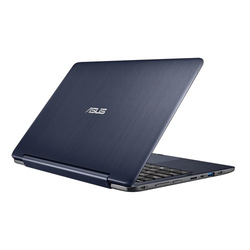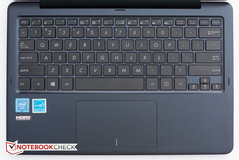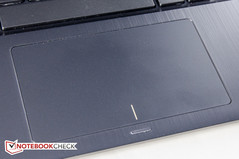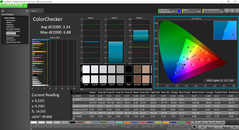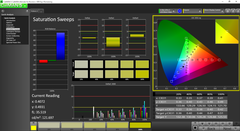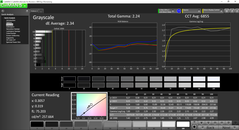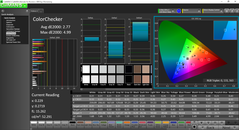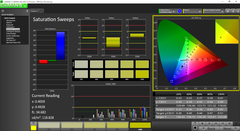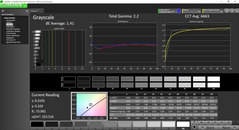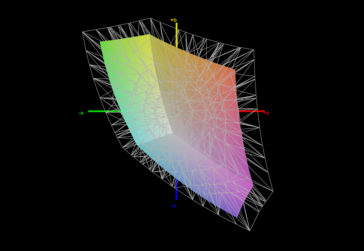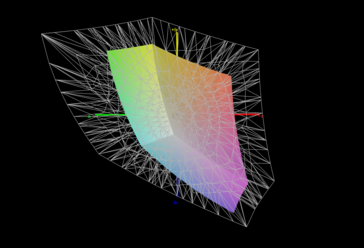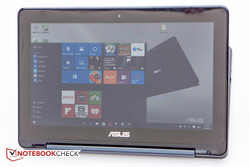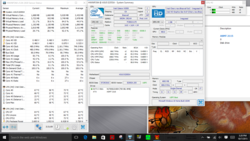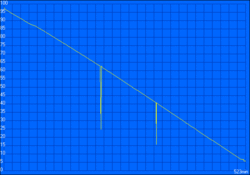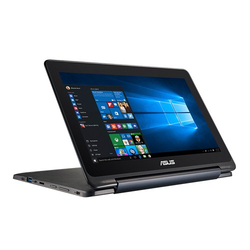Asus Transformer Book Flip TP200SA Convertible Review

Looking at the name only, one might think that the 11.6-inch Asus Transformer Book Flip TP200SA-DH04T is merely a Braswell and Windows 10 update of the older Transformer Book 200TA Convertible. That's not correct though, as last year's model was essentially a larger version of the company's successful 10-inch Transformer Book T100TA and as such not a true 2-in-1, but rather a tablet with a separate keyboard / hard drive dock. With the new TP200SA, Asus eschews the tablet-plus-base concept and joins the rather crowded "flip" convertible-market with a true 2-in-1 design. Together with the new TP200SA, Asus also announced an update of the original - and detachable - 10.1-inch Transformer Book, called T100HA with Intel Cherry Trail processor for $300. At the time of writing, the only available model of the TP200SA comes with an Intel Braswell Celeron CPU and 64 GB of eMMC flash storage for a fairly low MSRP of $350.
Competitors are a-plenty and include - among others - the Acer Aspire R11 R3-131T, the Toshiba Satellite Radius 11 L10-B-101, HP's Pavilion 11-n070eg x360 and Stream 11 X360, and the much more expensive Lenovo Yoga 3 11. In the following review we are going to take a detailed look at Asus' new offering and check if it stands out in the sea of other convertible models.
Case
The TP200SA looks quite stylish thanks to a brushed metal display lid in "Dark Blue" with "Crystal Silver" as the only other color option. According to Asus, the finish is both durable and scratch resistant. Of course we couldn't put that statement to the test, but we have to note here that the lid is an absolute magnet for fingerprints and thus very tough to keep smudge-free. Inside, the convertible can't deny its budget-origin with a plastic keyboard deck carrying over the design from the lid. The rather prominent bezel is covered by the protective glass screen. Having a larger bezel is not a drawback: in tablet mode there's enough room for the thumb to hold the unit without accidentally triggering inputs. The bottom of the convertible is black and smooth unfinished plastic. The hinge mechanism, which has been tested to 20K actuations according to Asus, is hidden by a long plastic cover which flexes a bit much when holding the convertible with its lid closed at the spine. Even though it opening the display requires both hands, we found the overall hinge stiffness lacking somewhat, as tapping at the display induces noticeable bouncing and even occasional angle changes.
While the lid is quite sturdy and resilient to pressure, the base unit is quite thin - according to our calipers it measures 11 mm at the thickest point - and twists rather easily while protesting with creaking sounds. Holding the convertible on the bottom left corner revealed one additional weakness: every time we handled the TP200SA that way, the first left click afterwards required more pressure and the pad emitted a more pronounced "click". A closer inspection revealed that the lower left edge of the touchpad-surface lifts up slightly when the case is twisted by holding it at the left corner and the mechanism catches somewhere internally, which in turn means that the more pressure is required to overcome the initial resistance. We don't know if all TP200-models are affected the same way nor do we know if that behavior is even a reason for concern, but we thought we should point it out. Overall build quality is very decent though with tight tolerances and smooth material transitions. At 1188 grams, the TP200SA is noticeably lighter than the budget-competition; only the Lenovo Yoga 3 11 - which costs about twice as much as our review convertible - weighs about 100 grams less. The HP Stream 11 X360 tips the scale at 1550 grams - a whopping 30 % more.
With its 360 degree hinge design, the Transformer Book Flip TP200SA supports four different modes: notebook, stand mode, tend mode and tablet. Asus FlipLock automatically disables the keyboard and the touchpad when the screen is tilted back beyond 180 degrees. Since there is no rubber bumper surrounding the bezel or the base unit, the TP200SA slides around quite easily on slick surfaces while in tent mode, so care needs to be taken to avoid costly accidents.
Connectivity
Despite its budget status, the convertible comes with a USB 3.1 Type-C port (Gen 1, which is equivalent to USB 3.0) - a rather nice addition, although peripherals supporting the new standard are still hard to come by. Still, the user can rest easily knowing that the TP200SA is at least future-ready in that department. The other physical ports are standard fare with Micro-HDMI and Micro-SD card reader in addition to a single USB 3.0 and USB 2.0 port. We are a little disappointed in Asus' choice to not include a full-sized SD card reader - all other competitors do include one. The HP Stream 11 X360 also comes with a full-sized HDMI port and a RJ45 connector, which our review notebook lacks.
Communication
The wireless module from Qualcomm (QCA9377) supports dual-band 802.11ac communication and does its job very well with decent range and no dropouts or other issues. Bluetooth 4.1 is supported and Miracast is on board as well.
Accessories
Aside from the rather small - and at 120 grams rather light - AC adapter, the carton is empty. A quick check on Asus' website showed no dedicated peripherals for the convertible, either.
Warranty
The Transformer Book Flip TP200SA is protected against manufacturers defects for a period of 12 months. We couldn't find warranty extensions on the dedicated product page, either, although there are plenty of third-party companies that offer such services.
Camera
While the previous-generation Transformer Book 200TA Convertible came with both a rear-facing 5 MP and a front-facing 2 MP camera, the TP200SA only features a front-facing unit with a paltry resolution of 0.3 MP (640 x 480 pixels). The video quality is marginal and stills are overly soft and characterized by high amounts of noise even in adequately-lit environments.
Software
The convertible runs Windows 10 Home 64-bit. We encountered quite a few unnecessary preinstalled titles like TripAdvisor, Netflix and Gameloft Games, among others. Considering the small drive, we would appreciate a more streamlined environment.
Maintenance
Although the bottom cover can be unscrewed and removed fairly easily, the upgradeability of the TP200SA is very limited. It might be possible to swap out the eMMC flash drive, but we did not investigate that possibility further.
Input Devices
Keyboard
The chiclet-style keyboard with its black plastic keys is not quite full-sized but easy to type on thanks to crisp feedback and generous key travel of 1.6 mm according to Asus, thus surpassing the notebook "standard" of 1.5 mm. While that's of course not noticeable when typing, the keyboard travel is certainly not nearly as shallow as what's commonly found on Ultrabooks and other slim-and-lights. The keyboard does yield a little to pressure in the middle, but it's not bouncy at all so we were able to type at a good clip with a very low error rate.
Touchpad
The smart-gesture touchpad is comfortably large at 104 mm x 61 mm (4.5 x 2.5 inches) and fingers glide easily and smoothly. The click-response is satisfying, although accompanied by a slight rattling noise. Touch gestures work without a hitch as well and there's even a three-finger tap-functionality to bring up Microsoft's Cortana digital assistant.
Touchscreen
The capacitive touchscreen supports up to 10 fingers and responds quickly to inputs. Thanks to the Windows Continuum mode, the display automatically changes based on the orientation of the convertible, which allows for a seamless transition from notebook to tablet mode.
Display
While most budget machines in this category come with low-quality TN displays, Asus equips its Transformer Book with a 1366 x 768 pixel display based on IPS technology. The brightness of the glossy panel measured across nine quadrants isn't outstanding, but still decent at 246 nits average and good enough to beat out most competitors. The HP Stream 11 x360 barely reaches 190 nits; only the significantly more expensive Lenovo Yoga 3 11 and ThinkPad Yoga 11e convertibles, which are equipped with IPS displays as well, are brighter. The contrast and black value are also quite decent with only the Acer R11 keeping up with the review notebook in this area.
| |||||||||||||||||||||||||
Brightness Distribution: 88 %
Center on Battery: 262.1 cd/m²
Contrast: 871:1 (Black: 0.301 cd/m²)
ΔE Color 3.24 | 0.5-29.43 Ø5
ΔE Greyscale 2.34 | 0.57-98 Ø5.3
58.8% sRGB (Argyll 1.6.3 3D)
40.6% AdobeRGB 1998 (Argyll 1.6.3 3D)
44.14% AdobeRGB 1998 (Argyll 2.2.0 3D)
64.4% sRGB (Argyll 2.2.0 3D)
42.72% Display P3 (Argyll 2.2.0 3D)
Gamma: 2.24
| Asus ASUS Transformer Book Flip TP200SA-DH04T IPS 1366x768 | Acer Aspire R11 R3-131T-C122 TN 1366x768 | HP Stream 11 X360 TN 1366x768 | HP Pavilion 11-n070eg x360 TN 1366x768 | Lenovo ThinkPad Yoga 11e 20D9000QGE IPS 1366x768 | Lenovo Yoga 3 11 80J8001WGE IPS 1920x1080 | |
|---|---|---|---|---|---|---|
| Display | -12% | 4% | ||||
| Display P3 Coverage | 42.72 | 37.53 -12% | 44.54 4% | |||
| sRGB Coverage | 64.4 | 56.4 -12% | 65.7 2% | |||
| AdobeRGB 1998 Coverage | 44.14 | 38.81 -12% | 46.15 5% | |||
| Screen | -88% | -116% | -101% | -36% | -33% | |
| Brightness middle | 262.1 | 261 0% | 197 -25% | 181 -31% | 285 9% | 290 11% |
| Brightness | 246 | 248 1% | 189 -23% | 161 -35% | 285 16% | 286 16% |
| Brightness Distribution | 88 | 90 2% | 91 3% | 83 -6% | 88 0% | 86 -2% |
| Black Level * | 0.301 | 0.3 -0% | 0.4 -33% | 0.37 -23% | 0.4 -33% | 0.42 -40% |
| Contrast | 871 | 870 0% | 493 -43% | 489 -44% | 713 -18% | 690 -21% |
| Colorchecker dE 2000 * | 3.24 | 12.64 -290% | 11.44 -253% | 10.11 -212% | 6.39 -97% | 6.5 -101% |
| Greyscale dE 2000 * | 2.34 | 13.75 -488% | 12.54 -436% | 10.72 -358% | 5.41 -131% | 6.35 -171% |
| Gamma | 2.24 98% | 2.88 76% | 2.45 90% | 2.7 81% | 2.76 80% | 2.44 90% |
| CCT | 6855 95% | 17914 36% | 14995 43% | 13522 48% | 6082 107% | 7156 91% |
| Color Space (Percent of AdobeRGB 1998) | 40.6 | 36 -11% | 42 3% | |||
| Color Space (Percent of sRGB) | 58.8 | 57 -3% | 65 11% | |||
| Total Average (Program / Settings) | -50% /
-69% | -116% /
-116% | -101% /
-101% | -36% /
-36% | -15% /
-24% |
* ... smaller is better
A check with a spectrophotometer reveals above-average accuracy with color and grayscale DeltaE-deviations of 3.24 and 2.34, respectively. For a budget notebook, these values are simply outstanding - and, as the screenshots below show, the display improves even more with a calibration. Unfortunately, the coverage of the professional colorspaces is not nearly as good with AdobeRGB-coverage only reaching about 41 %. We should add here though that the convertible is not suited for serious photo editing anyways, since neither the available storage space nor the processing performance are remotely sufficient.
Thanks to the decent enough brightness, which fortunately does not decrease when the convertible is running on battery power and the fairly high contrast ratio, the Transformer Book Flip is suitable for outdoor use as well. Direct sunlight should be avoided, since the glare-type screen is highly reflective, but working in the shade or on overcast days is possible as long as the display is adjusted properly.
Thanks to the superior IPS technology, the viewing angle stability of the Transformer Book Flip TP200SA is quite decent, although we did notice some dimming of the screen at more extreme angles. Still, the screen content remains visible and readable even if a user should venture way off to one side, so sharing the screen with friends to watch a movie is possible without restrictions. Convertibles with TN screens like the HP Stream 11 x360 don't work nearly as well in the above scenario.
Performance
Equipped with a budget dual-core Celeron CPU, 4GB of single-channel RAM and a 64 GB eMMC flash drive, the TP200SA is no speed demon, but can handle low-to-moderate-duty work like word processing, email, web browsing and video playback. At the time of writing, Asus only offers only one version of the 11.6-inch Transformer Book, although the spec sheet on the manufacturer's website also mentions an Intel Pentium processor as an option.
Processor
While the previous generation Transformer Book made use of an Intel Atom SoC, the new model comes equipped with the dual-core Intel Celeron N3050. The 14 nm Braswell-CPU has a nominal clock rate of 1.6 GHz, but can overclock to 2.16 GHz using its Turbo. During the CPU-specific Cinebench tests, the processor performed as expected at the maximum clock speed with no significant slowdown or throttling. The N3050 offers performance comparable to the previous-generation Celeron N2820; notebooks equipped with the Celeron N2840 (up to 2.58 GHz) - for example the Toshiba Satellite Radius 11 L10-B-101 - outperform the review candidate slightly. The Lenovo ThinkPad Yoga 11e is equipped with a previous generation quad-core Celeron and offers much better multi-core, but similar single-core performance; the Lenovo Yoga 3 11 comes with a dual-core Intel Core M-5Y10c and offers both much better multi-core as well as single-core performance.
| Cinebench R10 | |
| Rendering Single CPUs 64Bit (sort by value) | |
| Asus ASUS Transformer Book Flip TP200SA-DH04T | |
| Acer Aspire R11 R3-131T-C122 | |
| HP Stream 11 X360 | |
| Rendering Multiple CPUs 64Bit (sort by value) | |
| Asus ASUS Transformer Book Flip TP200SA-DH04T | |
| Acer Aspire R11 R3-131T-C122 | |
| HP Stream 11 X360 | |
System Performance
Our initial attempts of running the various benchmarks we normally use to evaluate overall system as well as component performance left us scratching our head, as some tests, like PCMark 8, for example, simply would not run; 3DMark 11 had a blank results page even though it appeared to complete successfully. Our initial analysis pointed towards the calibration software, but an uninstall didn't solve our problems. We then reinstalled the OS and ran the tests again but some results were still bewildering: the PCMark 8 Home and Creative scores, for example, ended up within a few points of each other. In order to not skew the results, we have omitted scores that we deemed unreliable. We should add here that we never had issues when used the TP200SA in "normal" fashion - only when running certain benchmarks. That said, the results of the PCMark 7 test show our review convertible to provide similar performance to the Acer Aspire R11 R3-131T, which is equipped with the same Celeron SoC and a 32 GB eMMC flash drive. The Toshiba Satellite Radius 11 L10-B-101 - despite having almost equal processor-performance - is about 30 % slower because it is held back by its conventional hard drive.
Storage Device
Since we were unable to run AS SSD and HD Tune due to errors, we had to rely on ATTO Disk Benchmark and CrystalDiskMark to evaluate the performance of the 64 GB eMMC flash drive. Performance is fairly typical: with average read and write speeds of about 160 MB/s and 68 MB/s, the drive is faster than a conventional hard drive, but still a lot slower than a regular SATA SSD drive - see for example the 128 GB Lite-On SSD drive in the Lenovo Yoga 3 11 in the chart below. For an eMMC flash drive, the 4K write performance is particularly impressive.
GPU Performance & Gaming
The Celeron SoC features an integrated HD Graphics with 12 EUs (Execution Units) and a clock speed of up to 600 MHz. The previous-generation BayTrail-M platform only offers about half the performance: the HP Stream 11 x360, for example, only scored about 230 points running the 3DMark 11 benchmark test, while the TP200SA scored close to 440 points. The new GPU supports DirectX 11.2, but is not powerful enough to handle any modern games. Even the older Anno 2070, which is known to not be very demanding on the hardware, only managed 12.7 fps at a resolution of 1366 x 768 with the settings on medium.
| 3DMark 11 Performance | 437 points | |
| 3DMark Ice Storm Standard Score | 17858 points | |
| 3DMark Cloud Gate Standard Score | 1516 points | |
| 3DMark Fire Strike Score | 232 points | |
Help | ||
| low | med. | high | ultra | |
| Anno 2070 (2011) | 30 | 12.7 |
Emissions
System Noise
Thanks to the extremely low TDP of only 6 watts, Asus was able to use passive cooling for the Transformer Book Flip TP200SA, so the system remains completely inaudible.
Temperature
For a fanless system, the convertible remains quite cool even when under load. We measured just above 41 degrees C on the top left side towards the back and just under 40 degrees C - a result that is quite acceptable considering that the Acer Aspire R11 R3-131T exceeded 48 degrees. The left palm rest reaches about 32 degrees, which means that the area is slightly warm to the touch, although not uncomfortably so.
(±) The maximum temperature on the upper side is 41.4 °C / 107 F, compared to the average of 35.3 °C / 96 F, ranging from 19.6 to 55.7 °C for the class Convertible.
(+) The bottom heats up to a maximum of 39.8 °C / 104 F, compared to the average of 36.8 °C / 98 F
(+) In idle usage, the average temperature for the upper side is 27 °C / 81 F, compared to the device average of 30.2 °C / 86 F.
(+) The palmrests and touchpad are cooler than skin temperature with a maximum of 31.8 °C / 89.2 F and are therefore cool to the touch.
(-) The average temperature of the palmrest area of similar devices was 28.1 °C / 82.6 F (-3.7 °C / -6.6 F).
Stress Test
To check the behavior under extreme conditions, we subject review notebooks to our stress test. With just Prime95 running, the CPU was able to maintain its maximum Turbo-speed of 2.16 GHz for extended periods of time with the CPU cores never exceeding 63 degrees C. With only Furmark active, the GPU generally maintained clock speeds of between 380 and 400 MHz - so shy of the maximum of 600 MHz. The temperature of the SoC stabilized at around 68 degrees after 10 minutes or so and did not change further.
With both Prime95 and Furmark running in parallel, we saw a drop of the CPU speed from about 1600 MHz down to 480 MHz after about 10 minutes with the GPU again at 400 MHz with dips to 380 MHz. The temperature rose briefly to 73 degrees C but stabilized at 68 degrees soon after. The bottom line here is that the SoC is subjected to fairly heavy CPU throttling when the CPU and the GPU are stressed simultaneously. Asus probably had to make that design choice to keep the temperatures of the fanless convertible in check.
Speakers
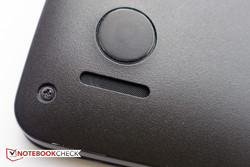
The stereo speakers are located on the bottom on the left and right front corners The maximum volume is adequate and the sound quality actually better than expected with decent highs and lows - even the bass is not completely lacking. Responsible for the good sound is the Asus AudioWizard EQ software, which can't be customized, but offers various presets for Music, Movie, Recording, Gaming and Speech Mode.
Battery Life
Asus promises a battery life of "up to 8 hours". During our WLAN-test, a script calls up various websites every 40 seconds until the battery is depleted. With the balanced profile enabled and the screen set to 150 nits, the convertible kept running for about 8 hours and 45 minutes. With the screen dimmed even more, we think that 10 hours should be achievable - an excellent result which surpasses the manufacturer's claim. The downward spikes in the screenshot on the right occurred in different spots every time we ran our test. So far, we have no explanation for this behavior. The Acer Aspire R11 R3-131T lasted about 2 hours longer browsing the web - not surprising, since its battery is significantly larger (50 Wh vs. 38 Wh). Still, the TP200SA should last most users an entire work day.
| Asus ASUS Transformer Book Flip TP200SA-DH04T | Acer Aspire R11 R3-131T-C122 | Toshiba Satellite Radius 11 L10-B-101 | HP Stream 11 X360 | HP Pavilion 11-n070eg x360 | Lenovo ThinkPad Yoga 11e 20D9000QGE | Lenovo Yoga 3 11 80J8001WGE | |
|---|---|---|---|---|---|---|---|
| Battery Runtime | 30% | -50% | -31% | -55% | -43% | -12% | |
| Reader / Idle | 1055 | 405 -62% | 725 -31% | 337 -68% | 856 -19% | ||
| WiFi v1.3 | 523 | 680 30% | 297 -43% | 443 -15% | |||
| Load | 268 | 170 -37% | 157 -41% | 260 -3% | |||
| WiFi | 232 | 396 | 217 |
Pros
Cons
Verdict
The slim-and-light Asus Transformer Book Flip TP200SA differs in many ways from the predecessor Transformer Book 200TA Convertible. One thing hasn't changed though: Asus still uses an IPS display despite the low price of $350. Other budget 2-in-1 convertibles cost close to the same amount but come with inferior TN displays. The color accuracy is incredible given the price point and the screen brightness is very decent. With a USB 3.1 Type-C port, the TP200SA is future-ready as well. The Braswell Celeron SoC has enough power for basic tasks, but is of course not suitable for demanding applications or gaming. The battery life exceeds the manufacturer's claims and thanks to the fanless design, the Transformer Book Flip remains noiseless. Decent input devices round out the package.
We do wish Asus would offer additional versions of the TP200SA with more storage space. While 64 GB might look sufficient initially, it doesn't take long for the drive to fill up. We also don't know as to why we weren't able to successfully run certain benchmark tests. The performance of the little convertible seems to be on par with similarly equipped competitors otherwise and we never experienced any problems during normal use. The stability of the base unit could also be improved, but for a budget-device, we can't complain too much here.
For the given price point, the Asus Transformer Book Flip TP200SA is hard to beat and definitely worth taking a look at.
Asus ASUS Transformer Book Flip TP200SA-DH04T
-
10/09/2015 v4(old)
Bernie Pechlaner


 Deutsch
Deutsch English
English Español
Español Français
Français Italiano
Italiano Nederlands
Nederlands Polski
Polski Português
Português Русский
Русский Türkçe
Türkçe Svenska
Svenska Chinese
Chinese Magyar
Magyar